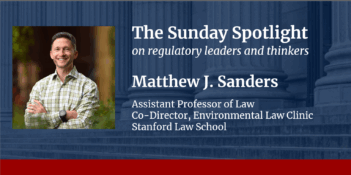
EPA must articulate and justify how its ozone decisions protect the public health.
This December, the Obama Administration will again have to decide how much air quality is needed to protect public health and welfare. Last year, the administration, after a prolonged internal battle, decided not to tighten the air quality standards for ozone because achieving the standards would be too costly. Now the administration will have to decide whether and how much to tighten the air quality standards for fine particles—those capable of penetrating into the deep lung.
Fine particles are, the Environmental Protection Agency (EPA) says, a threat to public health. The most important effect is premature mortality, particularly in the very old. Premature deaths number in perhaps the tens of thousands annually, often in the form of cardiovascular mortality. Other effects include increases in hospital and emergency room visits, and the development of chronic obstructive pulmonary disease. Those of low socio-economic status seem particularly at risk. And, so far as we know, there is no safe level of fine particles.
The Clean Air Act requires EPA to establish ambient air quality standards – limits on the permissible concentration of a pollutant in the air – for such pollutants. EPA first set ambient air quality standards for fine particles in 1997. The long-term annual standard—the key to reducing exposures—was set at 15 micrograms per cubic meter of air. After a prolonged judicial fight, these standards were upheld by the courts. In 2006, EPA decided not to tighten the 15 microgram standard despite the recommendation of the agency’s science advisors that it do so. The agency’s standard was remanded by the D.C. Circuit for failure to provide an adequate explanation–e.g. why the agency would not use studies of short-term effects to help set a standard for long-term effects, and vice versa. The court allowed the standard, though, to remain in place.
EPA has been ordered to complete its current review promptly, and has just issued proposed standards. The agency asked that it be given until August, 2013, to issue a final rulemaking; instead, the court set this December as the deadline. As a result, the fine particle standards will be the midnight rulemaking par excellence.
The agency deserves sympathy, even though its review was delayed—the staff that works on such standards has been steadily developing other air quality standards for the past six years. The time for action is so short that it will strain the agency’s scarce resources. Moreover, the task of standard-setting is quite difficult. It is hard to decide precisely the particle level that results in measurable premature deaths. So EPA must make a policy choice about how to deal with the uncertainties and gaps in what we know—that is, how protective should we be in the face of our ignorance.
Some commentators have suggested that Congress or EPA should set principles to follow in setting the standards. But while principles would help cabin EPA’s judgment, it seems unlikely that one could ever devise a principle for deciding, for instance, how much uncertainty is too much to justify regulation, or how to appraise a scientific study. Cost-benefit, advocated by some as a possible principle, contains many uncertainties. In general, any principles are bound to be so vague as to be of limited use.
This situation is hardly unique to environmental law. Doctors learn criteria to use in diagnosing and treating disease. Yet curing a patient cannot be reduced to rules, because it requires judgment. The same is as true in protecting public health. Indeed, the Clean Air Act recognizes this relationship when it says that standards to protect public health have to be requisite “in the judgment of the Administrator.”
Yet to say something is a matter of judgment does not immunize EPA. Administrative law sensibly mandates that an agency explain its judgment in a non-arbitrary matter. Being laypeople, we cannot expect to know as much as the expert, but we at least are entitled to an explanation we can understand—just as one would expect a doctor to explain in lay terms why one must undergo an uncomfortable medical test.
Unfortunately, EPA does not well explain its proposed decision to set the health-based standard in the 12-13 microgram range. EPA staff urged that the standard be set in the 11-12 range. Even the top of this level would be below the annual average at which health effects have been shown. A standard of 11 would afford a greater margin between the standard and the studies finding health effects. The staff added that considering a standard as high as 13 would be “reasonable” if the agency chose to discount on technical grounds the prime long-term study showing effects at lower levels than that. On the other hand, the staff conceded, there were still reliable studies showing effects below that level. Then, too, the staff said that there were uncertainties about effects occurring at the lower levels. Thus, the staff suggested that policymakers should consider the 11-13 range, and the agency’s science advisors concurred.
EPA opted for the high end. The agency acknowledges in the proposal that four studies show effects down to below 12 micrograms. But it picks 12 to 13 on the grounds that this range places the most emphasis on the most robust studies—without explaining why it decided that the studies showing lower effects are not robust enough. It also suggests that the 12-13 range offers an adequate margin of safety to account for our ignorance, as required by the Clean Air Act, but does not explain why or how.
Some in Washington believe that consideration of cost, although barred by the statute, influenced the decision, just as with the Obama Administration’s decision last year not to tighten the ozone standard. One account is that EPA decided that a standard of 11 would cause more unemployment than politically possible, and so the agency picked the high end of the plausible range.
It would not be surprising if this happened. As Senator Edmund Muskie, father of the Clean Air Act, remarked over thirty years ago, the failure to find safe levels means that the Administrator must make a pragmatic judgment about where to set the standard. Costs inevitably play a role; yet, benefits should play a role as well, and a standard of 11 would actually result in the greatest net benefits. The bar against considering cost is in part a way of telling the Administrator not to put much emphasis on cost. It also means that the Administrator, in setting a standard, must speak the language of public health.
Here the agency has so far failed to do so. This is undesirable because the proposed standard will attract a firestorm of criticism. Industry representatives are already arguing that the health effects do not arise from fine particles as a class, but rather are due to specific chemicals in the mass; taking that stance would exempt many sources needing to comply. Some in Congress are questioning, as with other EPA rules, the impact of the rules on a weak economy. And the standard will, of course, affect protection of public health. It is important for EPA to get the standard right and to articulate its rationales clearly.




